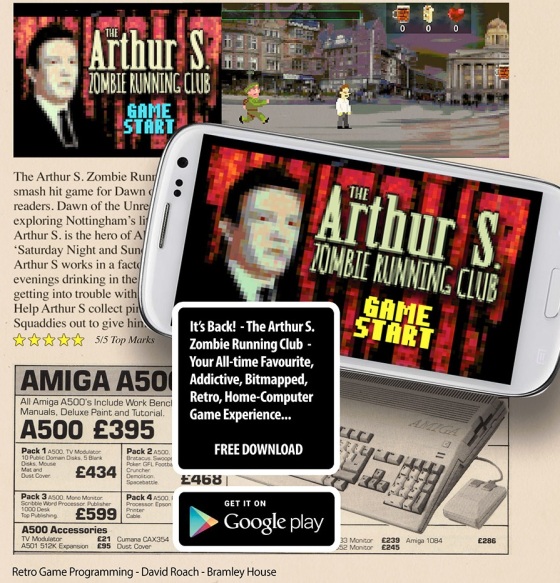One year ago I sat down with a games hobbyist called David Roach to discuss the possibility of creating a Saturday Night and Sunday Morning arcade game. For those who haven’t read the novel, here’s the digested read: Arthur Seaton works hard at his factory lathe, gets hammered at the weekend, has it off with a couple of sisters, gets beaten up by some squaddies and then settles down. We wanted to get across these themes while remaining sensitive to the needs of our target audience of 13+ reluctant readers.
The result is a very simple game whereby Arthur Seaton has to collect power-ups in the form of floating pints and kisses, while being chased by Squaddies. We opted for a retro look with pixelated graphics as this helped soften the themes of the book and meant we were less likely to be accused of glorifying alcohol and infidelity.

I was hoping that the game could be incorporated into the tasks set out in our ‘virtual library card’ and we could award bonus points to users who scored the highest. But linking Apps together turned out to be too difficult and time consuming to arrange. Instead it stands alone as a fun ‘add on’ that’s embedded into issue 12 of our comic: For it was Saturday Night.
This is the first game that David has officially submitted to Google Play and so I’m glad we’ve played a part in his first writing credit. He created it using Corona SDK, playing around with the demos available with the simulator and then built it piece by piece. “It’s a simple game,” he said “so I began by setting up the screen, displaying the graphics, adding buttons and then getting things to move. I used Sublime Text 2 to write the Lua code for Corona SDK. The graphics were made using a great iOS app called Sprite Something, with images manipulated and scaled up in Photoshop. The background tilemap data was created using a program called Tiled. The sound was made using Garageband and Audacity.”
The most difficult part for David was writing the code so that scene transitions finished at the end of the game. We were able to put him in touch with Iain Simons of Game City and other NTU staff, as NTU are a partner organisation on the project. But really, conquering code is down to mastering logic and sheer perseverance. When this failed there was always the kindness of strangers on forums.
The background scenes in the game are a mix of old and new locations around Nottingham. For example, it includes Nottingham University’s Jubilee Campus which used to be the location of Raleigh’s Sturmey Archer site, where Arthur Seaton and half of Radford worked during the 1950s. Pixelating the graphics meant we avoided any possible copyright infringements with photographs we used, though this wasn’t too much of an issue as we didn’t need big file sizes and so could use low resolution images from creative commons sites.
I wanted to use Whigfield’s Saturday Night as the musical score because it’s very recognisable and adds to the humour of the game. But David was really worried about this and so put the opening chords on a loop. My attitude to copyright in these situations is ‘fair use’ as our project is educational and we aren’t making any money out of it. In the worst case scenario we would simply take it down. We also used bit music – where the song is reduced to basic chords. This meant we weren’t using the original and the broken up chords matched the broken up graphics.
Paul Fillingham created a brilliant promo video which used an old modem dial-up and was overlaid with a staccato narrative, which again fit perfectly with the theme of the retro game. There’s nothing like nostalgia to get the creative juices flowing.
Dawn of the Unread is a constantly evolving experiment to find as many ways into literature as possible to raise awareness of important books in Nottingham’s literary history. We have a Flickr, Tumblr and Instagram account offering a visual history of books, music videos with a literary twist, photo essays, we tweet books, encourage our readers to create their own stories, embedded contextual essays, and of course a graphic novel which has been extended to sixteen chapters. We hope that casual readers will stumble across one of these modes of expression and from this discover the joy of books.
If you’d like to get involved or have an idea about something we haven’t tried, please get in contact. What better way to celebrate our one hundredth blog post…
RELATED READING
- Game Design Basics and Using Transition Library (coronalabs.com)
- My Video Games Collection (classicgamesblog.com)
- The Start of Something Big (retrogamingroundup.com)
- National Video Game Archive (iainsimons.com)
- Official Whigfield Fan Club: Brazil and Portugal (whigfieldofficialfanclub.blogspot.co.uk)
- Digital storytelling at Game City (jameskwalker.co.uk)
- Raleigh versus Rivethead (sillitoetrail.com)


